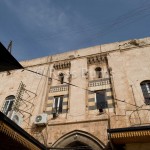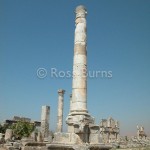A
B
C
D
E
F
G
H
I
J
K
L
M
N
O
P
Q
R
S
T
U
V
W
X
Y
Z
Full List

This curious temple, one of the rare remains from the period of transition between the Bronze and Iron Ages, lies on a tell situated on the west bank of the Afrin River, not far north of the Church of St Simeon. Its discovery has provided important clues on the development of religious structures at the […]

This bridge is difficult to reach, lying at the far northeastern corner of Syria, right on the short stretch of the Tigris River shared with Iraq. Caution is needed in approaching the site. The first bridge on this spot may have been a Roman structure, forming the connection between the frontier districts of the Empire […]

These views of the great medieval Citadel, constructed during the Zengid, Ayyubid and Mamluk periods, show how the city has grown to enfold what was once its protective strongpoint. The sight of the Citadel rearing above the densely packed urban spread has long stimulated European travellers’ fascination with the city whose heritage encompasses a greater […]

Those who have fantasized for many years over the castles of the Crusaders need to prepare themselves for a different experience at the Citadel of Aleppo. Fortification techniques were developed on a unique plan in the Islamic world at the time of the Crusades. We see may examples in Syria of these ideas with a […]

plan Aleppo Great Mosque Jan 2016 The Great Mosque within the walled city of Aleppo is unjustly given second billing after the Great Mosque of the Umayyads in Damascus. While it lacks the richness of the associations with early Islam and the Roman predecessor on the Damascus site, the Aleppo Great Mosque has its own […]

Only a short walk around the perimeter of the Great Mosque in Aleppo takes the visitor through many eras of the city’s history including a Byzantine-era synagogue converted to a mosque in the Islamic Middle Ages, two important khans (caravanserais) of the early Ottoman period and a twelfth century Zengid palace. For a full description, […]

This itinerary described on pages 43 to 44 of Monuments of Syria (third edition, I B Tauris, London, 2009) takes the visitor through some of the busiest suqs of the old city with diversions to an interesting variety of religious establishments of the Ayyubid and Mamluk eras. The itinerary ends at the city’s western […]

South of the main suqs of the central walled city of Aleppo. This itinerary includes one of the projects of the great Ottoman architect, Sinan (the Mosque al-Adeliye), a rare surviving examples of an Ayyubid khan or caravanserai, a remarkably intact example of a Mamluk asylum for the insane, a Mamluk mosque built with remains […]

The zone south of the main entrance to the Aleppo Citadel was developed as a ceremonial area aligned with the great gateway ascending to the fortifications. Here was buried the great leader of Aleppo’s resistance to the Crusades, al-Zaher Ghazi (ruled Aleppo and a wide stretch of territory east into Mesopotamia from 1186-1216. The Ottomans […]

This itinerary takes the visitor through the southern gate of the walled city of Aleppo to the important area of religious shrines and tombs to the south, ending at the Shrine of Abraham (Maqam Ibrahim al-Salihin). The highlight of this itinerary (and one of Aleppo’s hidden gems) is surely the superb ‘School of Paradis’ built […]

This short itinerary largely concentrates on the magnificent collection housed in the Aleppo branch of the National Museum whose holdings cover all eras of the city’s history as well as of the northern Syria and Euphrates regions. A short diversion at the end takes in the monuments behind the Museum reaching into the Bab al-Faraj […]

Jdeide (‘new’) Quarter lies just outside the northern walls of the old city of Aleppo. Its name ‘new’ indicates that it was established in the seventeenth century as an extension of the city particularly for those employed by the foreign consulates and ‘factories’ as local employees. Today it still houses an important collection of schools […]

This group of monuments lies on the northeastern edge of the traditional walled city extending as far as the Gate of Iron or Bab al-Hadid. It contains numerous monuments of significance though infrequently visited by tourists. In among the laneways behind the city walls lie buildings of the Ayyubid, Mamluk and Ottoman period as well […]

These two shrines lie on the hill of Jebel Jaushan to the south of the city. This was the vantage point of European travellers’ depictions of Aleppo from the seventeenth century (see itinerary 1). Both shrines have Shia associations reflecting the dominant influence of Shia traditions in Aleppo until the mid twelfth century before Nur […]

This unique site, mixing Phoenician, Achaemenid and Greek influences, liese on the coast below Tartus with a remarkable temple to Melqart, a Greek stadium and several monumental funerary towers. يعكس هذا الموقع الفريد تأثره بالحضارات الفينيقية والفارسية (الإخمينية) والإغريقية وكيف تم مزجها معاً، يقع على الساحل جنوب طرطوس ويضم معبداً مميزاً للإله ميلكارت، ومدرجاً […]

The Byzantine settlement at Anderin on the northwestern edge of the Syrian Steppe, east of Hama, has provided evidence of a barracks complex probably funded by a local landowner, typical of the smaller fortified centres in the sixth century AD to keep the threat of nomad or Persian incursions at bay. Little remains above the ground […]

The young French artist, Louis-François Cassas, visited Antioch on his way to Palmyra in 1785. (See separate set on Palmyra.) The sketches he prepared at the time were later published in the form of lithographs, issued from 1799. These depictions give us important clues to the remains of the Byzantine and Crusader-era fortifications and gates […]

Apamea was a Hellenistic foundation, one of the major centres of Hellenistic colonization in Seleucid syria. Its extensive walls reflect its importance as a military centre with rich pastures for the cavalry’s horses. Its most striking feature is the long cross-city axis marked by columns on each side with lavish provisions for public buildings, shops […]

This small island lies just off the Syrian coast at Tartus. It houses two intact castles of the Crusader and Ayyubid period along with remains of the island’s Phoenician sea walls. تقع هذه الجزيرة الصغيرة على مقربة من الساحل السوري مقابل طرطوس. تضم قلعتين من العصرين الأيوبي والصليبي ما تزالان بحالة جيدة، إضافة للأسوار المجاورة […]

This small town contains two almost identically designed Roman temples, delicately fashioned from the local basalt stone. The south Temple stems from the Antonine period (AD 151) the second or North Temple (probably dedicated to the Nabataean deity, Theandrites) was built in AD 211–212. تضم هذه المدينة الصغيرة معبدين من العصر الروماني متطابقي التصميم تقريباً، […]



















